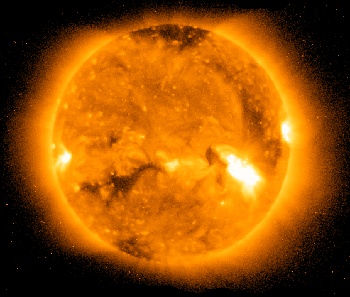Orbital Solar Energy
November 21, 2011
New Jersey, where I reside, isn't the sunniest of places, but somehow it's just second to
California in
photovoltaic capacity. The
Solar Energy Industries Association lists California's installed capacity at 94
megawatts, and New Jersey's at 75.7 megawatts.[1-2] Perhaps that thought will keep me warm when I'm shoveling
snow in a few more weeks. Imagine how much more effective our photovoltaics would be if we had clearer skies; or, if
daylight periods were longer.
One way to accomplish this is to put our photovoltaic arrays outside
Earth's atmosphere in space. Just as the idea of
geostationary communications satellite originated with
science fiction author,
Arthur C. Clarke, the idea of solar energy from space was the brainchild of another science fiction author,
Jerry Pournelle.[3] At the time of Pournelle's writing, the
economics of this didn't make sense, but it may be time to revisit the concept.
Such a reassessment has been presented in a recent report by the
International Academy of Astronautics (IAA) entitled, "Space Solar Power, The First International Assessment Of Space Solar Power: Opportunities, Issues And Potential Pathways Forward."[3-6] This voluminous, 248-page study, edited by
NASA veteran,
John Mankins, took two years to complete.[3] For those of you who might be wondering,
carbon nanotube extension cords are not required. The
power would be beamed to Earth using tight
microwave beams.

GEOS-13 Solar Xray Imager, first public image, July 6, 2006,
(Via NOAA National Weather Service Space Weather Prediction Center))
Envisioned are
square kilometer arrays of photovoltaic cells in Earth orbit. These would need to be assembled from individual components. To get an idea of the power that would be available, the
power of the Sun incident on the Earth above the atmosphere is about 1,366 watts per square meter, as averaged over the course of a year. If our photovoltaic array
efficiency, including the necessary conversion to microwave energy, is just 20%, a square kilometer would provide about 275 megawatts of power.
The
Indian Point nuclear power plant, which contains three
reactors that supply a substantial portion of the electricity for
New York City and its suburbs, generates about 2,000 megawatts. Obviously, many square kilometers of photovoltaics would be required in space just to offset nuclear energy.

A nineteen megawatt peak power photovoltaic system near Thüngen, Bavaria, Germany.
(Photo by Oh Weh, via Wikimedia Commons))
The availability of solar power at night is a major advantage of a space-based system, but such a system has one major disadvantage. It could be used as a
weapon, and space-based energy weapons have made several appearances in
James Bond movies. As it is, control of the microwave beam so that it's aimed precisely at the reception station would be a major undertaking,[3] and
maintenance and repair operations in space would need to be continuous.
The IAA study determined that technologies have been demonstrated in the
laboratory to make this venture feasible within two decades; and that the economics of such an energy source have improved due to the need for
"green" energy.[6] The report claims that orbital solar will be competitive with other energy sources within thirty years, but it didn't propose a
roadmap or a specific
architecture. [5-6]
Much of the system cost would be in the
vehicles that lift the components into orbit. The IAA study estimated that several tens of billions of dollars would be required for the development and construction of a fleet of low-cost, reusable, vehicles.[6] Mankins, editor of the IAA study, is also president of
Artemis Innovation Management Solutions LLC, a California consulting company. NASA has given Artemis a small contract to pursue space-based solar power options.[5]
References:
- Bob Holt, "New Jersey passes California in solar," Newjerseynewsroom.com, October 4, 2011.
- Solar Energy Industries Association Web Site.
- Richard Chirgwin, "Enormous orbiting solar raygun power plants touted - Trusty scientifiction staple gets another outing," The Register (UK), November 15, 2011.
- John C. Mankins, Editor, "Space Solar Power, The First International Assessment Of Space Solar Power: Opportunities, Issues And Potential Pathways Forward," International Academy of Astronautics, 2011, 249 page PDF File.
- Jim Wolf, "Orbital solar power plants touted for energy needs," Reuters, November 13, 2011.
- Giant orbiting power plants could harvest the sun's energy to provide world's power needs, Daily Mail (UK), November 15, 2011.
Permanent Link to this article
Linked Keywords: New Jersey; California; photovoltaic; Solar Energy Industries Association; megawatt; snow; daylight period; Earth's atmosphere; geostationary communications satellite; science fiction; Arthur C. Clarke; Jerry Pournelle; economics; International Academy of Astronautics; NASA; John Mankins; carbon nanotube; extension cord; electric power; microwave; NOAA National Weather Service Space Weather Prediction Center; square kilometer; Solar constant; energy conversion efficiency; Indian Point nuclear power plant; nuclear reactor; New York City; Oh Weh; Wikimedia Commons; weapon; James Bond movie; maintenance and repair operations; laboratory; green energy; technology roadmap; system architecture; spacecraft; Artemis Innovation Management Solutions LLC.